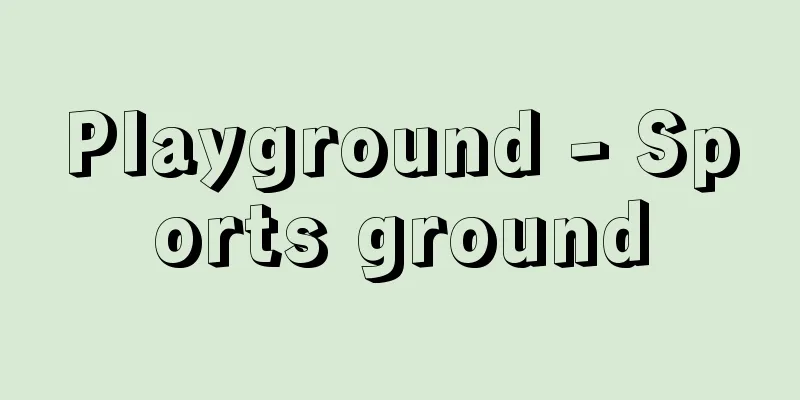Playground - Sports ground

|
A specific location equipped with the equipment and facilities necessary for physical education and sports. In the Ministry of Education, Culture, Sports, Science and Technology's "Survey on the Current Status of Physical Education and Sports Facilities" (2002), physical education and sports facilities are classified as school physical education and sports facilities, university (junior college) and technical college physical education and sports facilities, public sports facilities, workplace sports facilities, and private sports facilities, and athletic fields are counted as one of the school physical education and sports facilities. Playgrounds can be broadly divided into school playgrounds used for physical education and public playgrounds used primarily for sports, and each is provided according to the type and purpose of the users. [Kenji Kasama] School playgroundSchool playgrounds are required by the School Education Law Enforcement Regulations. Historically, they were established and developed as the subject of gymnastics was enhanced with the development of the modern school system. In particular, the Elementary School Act of 1900 (Meiji 33) made gymnastics a compulsory subject and required a gymnastics ground, and set out area standards, which promoted the establishment of playgrounds. Behind this was a strong demand for nationalistic education, which saw gymnastics as a means of strengthening mental strength and inspiring morale, thus raising nationalism. The area standards were abolished in 1904, but they were followed as an unwritten rule when establishing elementary school playgrounds until World War II. Currently, the area standards for outdoor athletic fields are stipulated by the "Installation Standards" for each type of school (kindergarten, elementary school, junior high school, and high school). However, in urban areas, schools are unable to secure sufficient area, so rooftop athletic fields are used as a supplement. Indoor athletic fields are generally called gymnasiums, and area standards are set as targets for national treasury subsidies. School playgrounds are not only places for physical education, but also free playgrounds for students and are widely used for school events such as special activities and sports days. In addition to promoting balanced physical growth and maintaining a healthy condition, it is expected that play and group activities on the playground will foster cooperation, autonomy and spontaneity. Therefore, the construction and use of facilities must be carried out with sufficient educational consideration. The playground should be located on the south side of the school building where it gets plenty of sunlight. It is necessary to improve the environment by providing a surrounding planting belt, grass or shrubs between classrooms, and appropriate placement of drainage ditches, foot washing areas, and drinking fountains. Various playground equipment and sports facilities must also be appropriately arranged, taking into consideration the grade level. In elementary schools, where there is a large difference in the stage of mental and physical development, dedicated playgrounds are required for the lower grades (1st and 2nd grade) to prevent pressure and injuries. In urban schools, playgrounds are paved with asphalt or other materials other than dirt. This is thought to be a measure to prevent dust and other school environmental issues, but it must be carefully considered from the perspective of the impact on the physical development of children and students and the prevention of injuries. Even if the surface is paved, it is necessary to use a resilient surface taking into consideration the hardness of the surface, and various considerations and measures are required, especially from the perspective of injury prevention. [Kenji Kasama] Public playgroundPublic sports grounds are increasing as public sports grounds of local governments, commercial facilities of the leisure industry, and welfare facilities of companies, but the number of facilities is still not sufficient. Today, as the demand for sports that correspond to each life stage of the people is increasing, the idea of "lifelong sports" has been advocated, where everyone can enjoy sports at any time and anywhere in their life. In order to meet such demands, it is necessary to open school sports facilities, which account for about 60% of physical education and sports facilities, to local residents. The opening of school facilities was promoted by a notice from the Vice-Minister of the Ministry of Education in June 1983 ("On the Promotion of Sports, Culture, and the Arts in the Community"), but the reality is that it has not yet fully responded to the demands of the community due to the complicated procedures for use and the lack of information on how to use them. From the viewpoint that school facilities are the common property of the community, it is desirable that school sports facilities, including playgrounds, be actively opened to local residents for sports and recreational activities as long as it does not interfere with educational activities. In doing so, sufficient consideration must be given to crime prevention measures to ensure the safe management of school facilities. [Kenji Kasama] [Reference items] | | | | | |Source: Shogakukan Encyclopedia Nipponica About Encyclopedia Nipponica Information | Legend |
|
体育やスポーツを行うために必要な設備や施設を備えた一定の場所。文部科学省の「体育・スポーツ施設現況調査」(2002)では、体育・スポーツ施設は、学校体育・スポーツ施設、大学(短期大学)・高等専門学校体育・スポーツ施設、公共スポーツ施設、職場スポーツ施設、民間スポーツ施設に分けられ、学校体育・スポーツ施設の一つに運動場が数えられている。 運動場は、体育を目的とした学校運動場とスポーツをおもな目的とした公衆運動場とに大別することができ、それぞれ利用者の種類や目的に沿って、合目的的に設けられている。 [笠間賢二] 学校運動場学校運動場は学校教育法施行規則によってかならず備えなければならないとされている。歴史的には、近代学校制度の整備に伴い、教科としての体操が充実される過程で設置、整備されてきた。とくに1900年(明治33)の小学校令が体操科必修、体操場必備とし、面積基準を示したことが運動場の設置を進めた。この背景には、体操を気力の鍛錬、士気の鼓舞というナショナリズム興起の手段とする国家主義的教育の強い要請があった。面積基準は1904年に廃止されたが、第二次世界大戦以前はこれが小学校運動場設置の際の不文律として準拠されてきた。 現在、屋外運動場の面積基準は学校種(幼・小・中・高)ごとの「設置基準」によって法定されている。しかし都市部の学校では十分な面積を確保できないのが実情であり、そのために屋上運動場が補助として使用されている。なお、屋内運動場は一般に体育館とよばれ、国庫補助の対象として面積基準が示されている。 学校運動場は体育科教育の場であるだけでなく、児童・生徒の自由な遊び場でもあり、また特別活動や運動会などの学校行事にも広く活用されている。均衡のとれた身体の成長とその健全な保持に加え、運動場での遊びや集団活動を通して、協調性や自律性、自発性を育成することが期待される。したがって、施設の整備と使用については十分な教育的配慮が図られねばならない。 運動場の位置は日当りのよい校舎の南側とし、周囲の植樹帯、教室との間の芝生や植え込みなどの環境整備、排水溝、足洗い場、水飲み場などの適正な配置、などのくふうが必要である。各種の遊具や競技用の設備も、学年を考慮して適切に配備されなければならない。また心身の発達段階に差異の大きい小学校では、低学年生(1~2年)の受ける圧迫や傷害防止のため、専用の遊び場が必要とされる。また、都市部の学校では表面をアスファルトなどによって舗装した土以外の運動場がみられる。これは砂埃(すなぼこり)の防止など学校環境面からの措置と考えられるが、むしろ児童・生徒の身体の発育に及ぼす影響や傷害防止の観点から慎重に検討されなければならない。舗装する場合でも、その硬さを考慮して弾力性のある舗装にする必要があるし、とりわけ傷害防止の観点からさまざまな配慮と対応が必要となる。 [笠間賢二] 公衆運動場公衆運動場は、地方公共団体の公共運動場、余暇産業の商業的施設、企業の福利厚生施設として増加してきているが、いまだ十分な施設数に達しているとはいえない。国民の各ライフステージに応じたスポーツへの要求がとみに高まりつつある今日、国民のだれもが生涯の各時期にわたって、いつでも、どこでもスポーツを楽しむことができる「生涯スポーツ」の考え方も提唱されている。こうした要求に応えるためにも、体育・スポーツ施設の約6割を占める学校体育施設の地域住民への開放が求められている。学校施設の開放については1983年(昭和58)6月の文部省事務次官通知(「地域のスポーツ、文化、芸術の振興について」)によって促進策がとられたが、利用手続の煩雑さや利用方法などに関する情報提供の不足などから、いまだ地域の要求に十分に応えていないのが実状である。学校施設が地域の共有財産であるという観点にたてば、教育活動に支障がない限り、運動場を含めた学校体育施設が地域住民のスポーツやレクリエーション活動に積極的に開放されることが望まれる。その際、学校施設の安全管理のためにも、防犯対策に十分な配慮がなされなければならない。 [笠間賢二] [参照項目] | | | | | |出典 小学館 日本大百科全書(ニッポニカ)日本大百科全書(ニッポニカ)について 情報 | 凡例 |
>>: Ataxia - Athlete's condition
Recommend
Coronary artery disease
…coronary artery disease is a general term for di...
tax avoidance
...Actions aimed at reducing the tax burden of ta...
Indirect steelmaking process
…At this stage, the steel still contains a consid...
Harriotta raleighana (English spelling) Harriottaraleighana
…It can reach a total length of 130 cm. It is dis...
Aowakame - Aowakame
…Table 2 shows the main processed products, but i...
Ibn Barkhī (English spelling)
...This work influenced other Arab countries, and...
Arab Socialist Union
...The leadership was formed by a core of Free Of...
Miki Rofu - Mikirofu
Poet. Real name Misao. Born on June 23, 1889 in T...
Procalyote
...However, in all animals and plants, genetic DN...
O'Sullivan, JL - O'Sullivan
...A typical example of American expansionism, tr...
Organic Chemical Industry
Chemical industry is a process that separates or s...
short-finned pilot whale
...There are two species currently living. In Jap...
Patres ecclesiae; church fathers
The term means "father of the church." I...
Neuroptera
…an order or superorder of the class Insecta. Thi...
Kisoji Katada - Cleaning Katada
Head of the Katada family of Nagauta musicians. Th...









